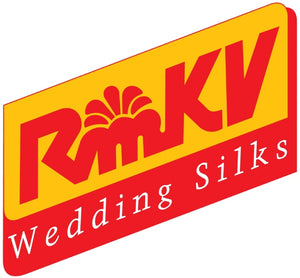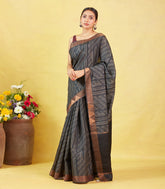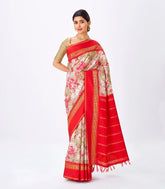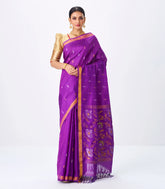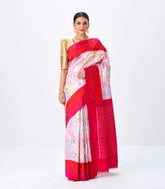-
Black Handloom Tussar Silk Saree With Printed Stripes Motifs
This handwoven tussar silk saree is printed with stripes motifs in black body along with border and palluMRP:- ₹15,200
- ₹15,200
- Unit price
- per
-
Lilac Handloom Tussar Silk Saree With Printed Border
This handwoven tussar silk saree is filled with floral motifs in lilac body along with printed floral motifs in border and palluMRP:- ₹22,400
- ₹22,400
- Unit price
- per
-
Dark Grey Handloom Tussar Silk Saree With Printed Floral Motifs
This handwoven tussar silk saree is printed with floral motifs in dark grey body along with contrast black border and palluMRP:- ₹19,200
- ₹19,200
- Unit price
- per
-
Beige Handloom Silk Saree With Printed Floral Motifs & Red Border
This handwoven silk saree is digital printed with floral motifs in beige body along with contrast red temple border and palluMRP:- ₹14,700
- ₹14,700
- Unit price
- per
-
Baby Pink Handloom Silk Saree With Printed Floral Motifs & Red Border
This handwoven silk saree is digital printed with floral motifs in baby pink body along with contrast red temple border and palluMRP:- ₹14,700
- ₹14,700
- Unit price
- per
-
Purple Handloom Uppada Silk Saree With Zari Buttas
This handwoven uppada silk saree is filled with zari buttas in purple body along with zari border and floral motifs in palluMRP:- ₹20,160
- ₹20,160
- Unit price
- per
-
Dark Green Handloom Uppada Silk Saree With Zari Buttas
This handwoven uppada silk saree is filled with zari buttas in dark green body along with zari border and bird motifs in palluMRP:- ₹20,160
- ₹20,160
- Unit price
- per
-
Lavender Handloom Uppada Silk Saree With Zari Buttas
This handwoven uppada silk saree is filled with zari buttas in lavender body along with zari border and floral motifs in palluMRP:- ₹20,160
- ₹20,160
- Unit price
- per
-
Baby Pink Handloom Uppada Silk Saree With Zari Buttas
This handwoven uppada silk saree is filled with zari buttas in baby pink body along with zari border and floral motifs in palluMRP:- ₹20,160
- ₹20,160
- Unit price
- per
-
Baby Pink Handloom Silk Saree With Printed Flower Motifs
This handwoven silk saree is digital printed with floral motifs in baby pink body along with tie & dye chevron motifs in border and palluMRP:- ₹28,000
- ₹28,000
- Unit price
- per
-
Baby Pink Handloom Silk Saree With Printed Floral Motifs
This handwoven silk saree is digital printed with floral motifs in baby pink body along with tie & dye motifs in border and palluMRP:- ₹28,000
- ₹28,000
- Unit price
- per
-
Red Handloom Uppada Silk Saree With Peacock Zari Buttas
This handwoven uppada silk saree is filled with peacock zari buttas in red body along with zari border and floral motifs in palluMRP:- ₹36,094
- ₹36,094
- Unit price
- per
-
Turquoise Handloom Uppada Silk Saree With Meena Floral Motifs in Border
This handwoven uppada silk saree is filled with meena buttas in turquoise body along with meena floral motifs in border and palluMRP:- ₹45,045
- ₹45,045
- Unit price
- per
-
Crimson Handloom Tussar Silk Saree With Printed Dotted Motifs
This handwoven tussar silk saree is filled with printed with dotted motifs in crimson body along with contrast border and palluMRP:- ₹9,704
- ₹9,704
- Unit price
- per
-
Grey Handloom Plain Uppada Silk Saree With Zari Border
This handwoven uppada silk saree is filled with plain grey body along with zari border and palluMRP:- ₹5,760
- ₹5,760
- Unit price
- per
Subscribe To Our Newsletter
Receive early access to new arrivals, sales, exclusive content, events and much more!
